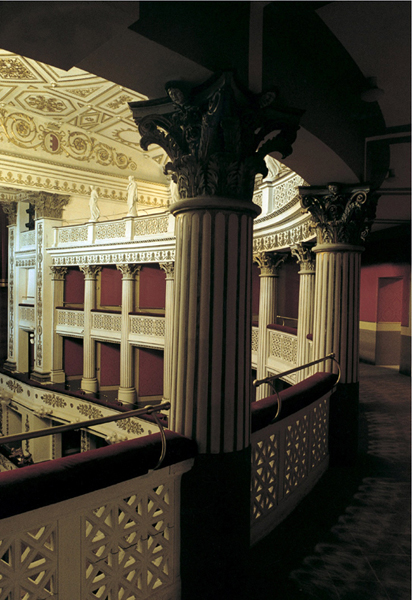|
Teatro Della Fortuna
The Teatro della Fortuna is a music and theater venue (opera house) in Fano, province of Pesaro and Urbino, region of Marche, Italy. The present building is, in general, the result of at least two nearly complete reconstructions. A palace built in 1299 at this site housed the Palazzo del Podestà of Fano. It was converted into a theater by the scenographer and entrepreneur Giacomo Torelli between 1665 and 1677. In 1839, that theater was closed due to the deterioration in the architecture and replaced in 1845-1869 by a new opera house designed by Luigi Poletti. That theater was severely damaged and nearly burned down in 1944 due to bombardments during the Second World War. After a laborious restoration in 1998 the theater was reopened. In recent years, the theater has hosted visiting performances from the Rete Lirica delle Marche. The main hall, the Sala Poletti, recalls the Neoclassical-style of the Poletti-designed opera house, but updated in various forms. The ceiling has a ... [...More Info...] [...Related Items...] OR: [Wikipedia] [Google] [Baidu] |
Fano
Fano is a town and ''comune'' of the province of Pesaro and Urbino in the Marche region of Italy. It is a beach resort southeast of Pesaro, located where the ''Via Flaminia'' reaches the Adriatic Sea. It is the third city in the region by population after Ancona and Pesaro. History An ancient town of Marche, it was known as Fanum Fortunae after a temple of Fortuna located there. Its first mention in history dates from 49 BC, when Julius Caesar held it, along with Pisaurum and Ancona. Caesar Augustus established a '' colonia'', and built a wall, some parts of which remain. In 2 AD Augustus also built an arch (which is still standing) at the entrance to the town. In January 271, the Roman Army defeated the Alamanni in the Battle of Fano that took place on the banks of the Metauro river just inland of Fano. Fano was destroyed by Vitiges' Ostrogoths in AD 538. It was rebuilt by the Byzantines, becoming the capital of the maritime Pentapolis ("Five Cities") that included also ... [...More Info...] [...Related Items...] OR: [Wikipedia] [Google] [Baidu] |
Marche
Marche ( , ) is one of the twenty regions of Italy. In English, the region is sometimes referred to as The Marches ( ). The region is located in the central area of the country, bordered by Emilia-Romagna and the republic of San Marino to the north, Tuscany to the west, Umbria to the southwest, Abruzzo and Lazio to the south and the Adriatic Sea to the east. Except for river valleys and the often very narrow coastal strip, the land is hilly. A railway from Bologna to Brindisi, built in the 19th century, runs along the coast of the entire territory. Inland, the mountainous nature of the region, even today, allows relatively little travel north and south, except by twisting roads over the passes. Urbino, one of the major cities of the region, was the birthplace of Raphael, as well as a major centre of Renaissance history. Toponymy The name of the region derives from the plural of the medieval word '' marca'', meaning "march" or "mark" in the sense of border zone, originall ... [...More Info...] [...Related Items...] OR: [Wikipedia] [Google] [Baidu] |
Palazzo Del Podestà, Fano
A palace is a grand residence, especially a royal residence, or the home of a head of state or some other high-ranking dignitary, such as a bishop or archbishop. The word is derived from the Latin name palātium, for Palatine Hill in Rome which housed the Imperial residences. Most European languages have a version of the term (''palais'', ''palazzo'', ''palacio'', etc.), and many use it for a wider range of buildings than English. In many parts of Europe, the equivalent term is also applied to large private houses in cities, especially of the aristocracy; often the term for a large country house is different. Many historic palaces are now put to other uses such as parliaments, museums, hotels, or office buildings. The word is also sometimes used to describe a lavishly ornate building used for public entertainment or exhibitions such as a movie palace. A palace is distinguished from a castle while the latter clearly is fortified or has the style of a fortification, whereas a ... [...More Info...] [...Related Items...] OR: [Wikipedia] [Google] [Baidu] |


